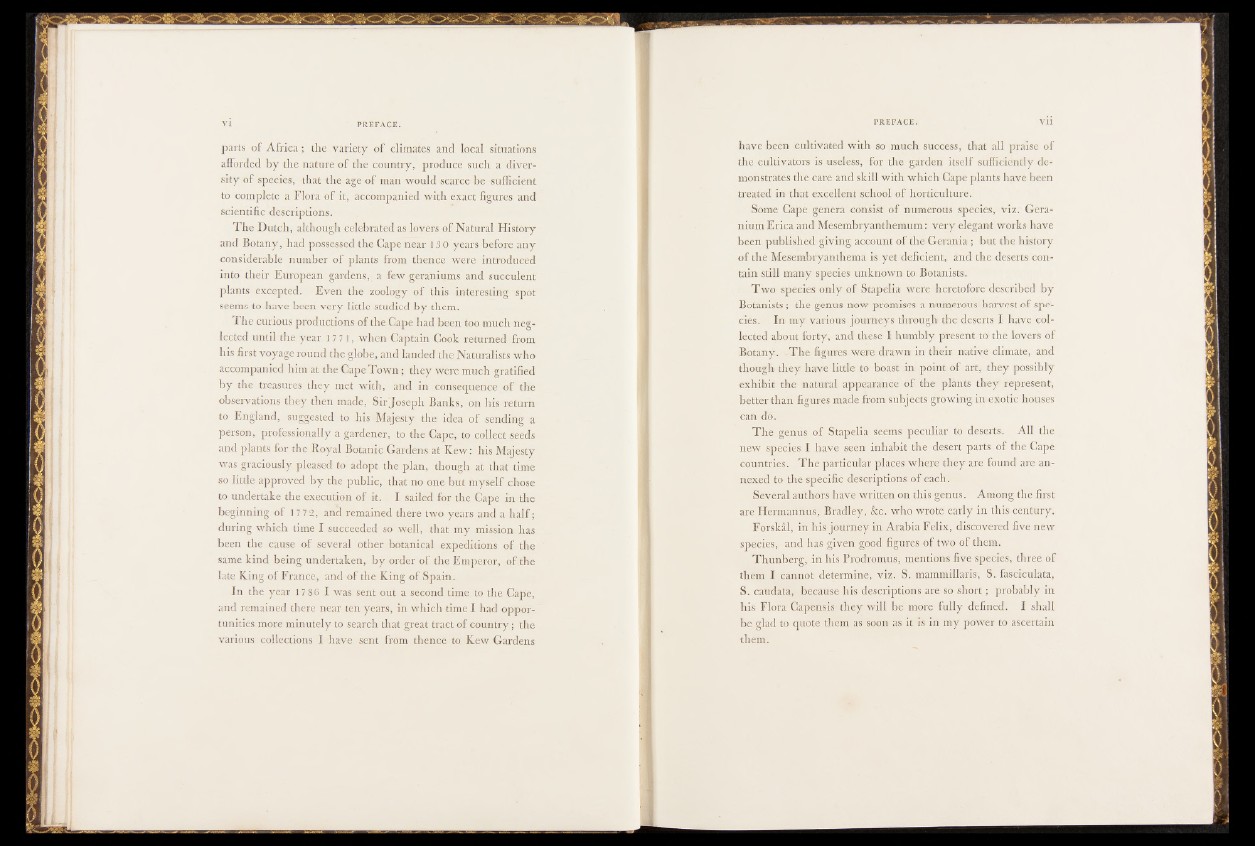
parts of Africa; the variety of climates and local situations
afforded by the nature of the country, produce such a diversity
of species, that the age of man would scarce be sufficient
to complete a Flora of it, accompanied with exact figures and
scientific descriptions.
The Dutch, although celebrated as lovers of Natural History
and Botany, had possessed the Cape near 15 0 years before any
considerable number of plants from thence were introduced
into their European gardens, a few geraniums and succulent
plants excepted. Even the zoology of this interesting spot
seems to have been very little studied by them.
The curious productions of the Cape had been too much neglected
until the year 17 7 1, when Captain Cook returned from
his first voyage round the globe, and landed the Naturalists who
accompanied him at the Cape Town; they were much gratified
by the treasures they met with, and in consequence of the
observations they then made, Sir Joseph Banks, on his return
to England, suggested to his Majesty the idea of sending a
person, professionally a gardener, to the Cape, to collect seeds
and plants for the Royal Botanic Gardens at Kew: his Majesty
was graciously pleased to adopt the plan, though at that time
so little approved by the public, that no one but myself chose
to undertake the execution of it. I sailed for the Cape in the
beginning of 1 7 72, and remained there two years and a half;
during which time I succeeded so well, that my mission has
been the cause of several other botanical expeditions of the
same kind being undertaken, by order of the Emperor, of the
late King of France, and of the King of Spain.
In the year 17 86 I was sent out a second time, to the Cape,
and remained there near ten years, in which time I had opportunities
more minutely to search that great tract of country; the
various collections I have, sent from thence to Kew Gardens
have been cultivated with so much success, that all praise of
the cultivators is useless, for the garden itself sufficiently demonstrates
the care and skill with which Cape plants have been
treated in that excellent school of horticulture.
Some Cape genera consist of numerous species, viz. Geranium
Erica and Mesembryanthemum: very elegant works have
been published giving account of the Gerania ; but the history
of the Mesembryanthema is yet deficient, and the deserts contain
still many species unknown to Botanists.
Two species: only of Stapelia were heretofore described by
Botanists ; the genus now promises a numerous harvest of spe.-
cies. In miy various journeys through the deserts I have collected
about forty, and these I humbly present to the lovers of
Botany. The figures were drawn in their native climate, and
though they have little to boast in point of art, they possibly
exhibit the natural appearance of the plants they represent,
better than figures made from subjects growing, in exotic houses
can do.
The genus of Stapelia seems peculiar to deserts. All the
new species I have seen inhabit the desert parts of the Cape
countries. The particular places where they are found are annexed
to the specific descriptions of each.
Several authors have written on this genus. Among the first
are Hermannus, Bradley, 8cc. who wrote early in this century.
Forskal, in his journey in Arabia Felix, discovered five new
species, and has given good figures of two of them.
Thunberg, in his Prodromus, mentions five species, three of
them I cannot determine, viz. S. mammillaris, S. fasciculata,
S. caudata, because his descriptions are so short; probably in
his Flora Capensis they will be more fully defined. I shall
be glad to quote them as soon as it is in my power to ascertain
them.